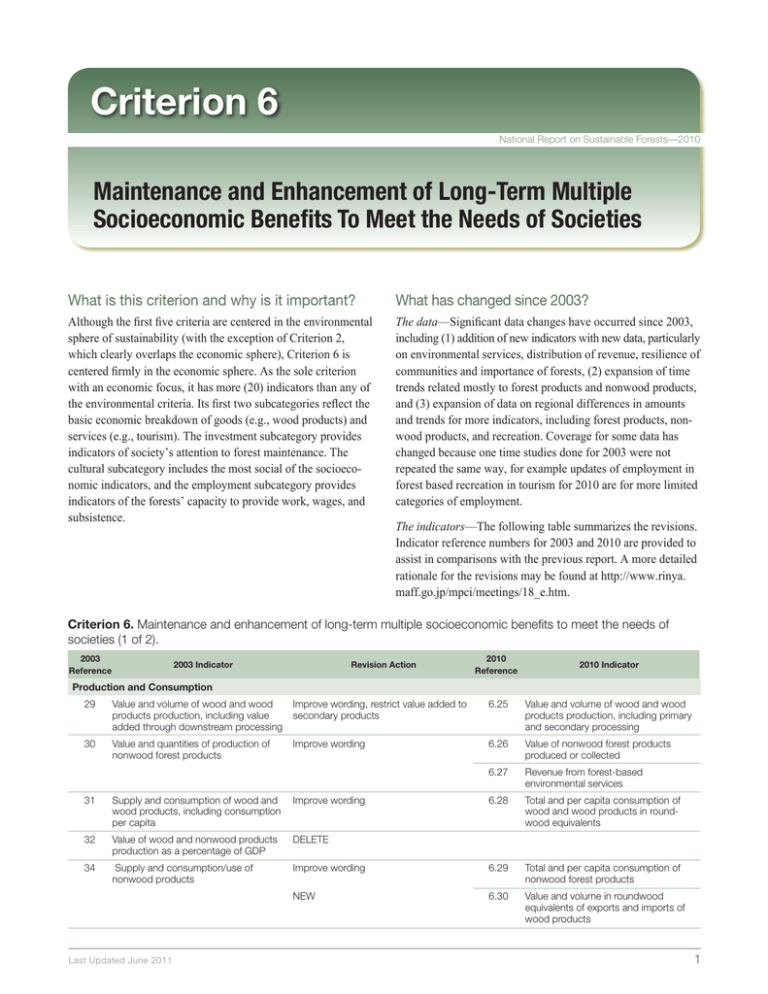Criterion 6
advertisement

Criterion 6 National Report on Sustainable Forests—2010 Maintenance and Enhancement of Long-Term Multiple Socioeconomic Benefits To Meet the Needs of Societies What is this criterion and why is it important? What has changed since 2003? Although the first five criteria are centered in the environmental sphere of sustainability (with the exception of Criterion 2, which clearly overlaps the economic sphere), Criterion 6 is centered firmly in the economic sphere. As the sole criterion with an economic focus, it has more (20) indicators than any of the environmental criteria. Its first two subcategories reflect the basic economic breakdown of goods (e.g., wood products) and services (e.g., tourism). The investment subcategory provides indicators of society’s attention to forest maintenance. The cultural subcategory includes the most social of the socioeconomic indicators, and the employment subcategory provides indicators of the forests’ capacity to provide work, wages, and subsistence. The data—Significant data changes have occurred since 2003, including (1) addition of new indicators with new data, particularly on environmental services, distribution of revenue, resilience of communities and importance of forests, (2) expansion of time trends related mostly to forest products and nonwood products, and (3) expansion of data on regional differences in amounts and trends for more indicators, including forest products, non­wood products, and recreation. Coverage for some data has changed because one time studies done for 2003 were not repeated the same way, for example updates of employment in forest based recreation in tourism for 2010 are for more limited categories of employment. The indicators—The following table summarizes the revisions. Indicator reference numbers for 2003 and 2010 are provided to assist in comparisons with the previous report. A more detailed rationale for the revisions may be found at http://www.rinya. maff.go.jp/mpci/meetings/18_e.htm. Criterion 6. Maintenance and enhancement of long-term multiple socioeconomic benefits to meet the needs of societies (1 of 2). 2003 Reference 2003 Indicator Revision Action 2010 Reference 2010 Indicator Production and Consumption 29 Value and volume of wood and wood products production, including value added through downstream processing Improve wording, restrict value added to secondary products 6.25 Value and volume of wood and wood products production, including primary and secondary processing 30 Value and quantities of production of nonwood forest products Improve wording 6.26 Value of nonwood forest products produced or collected 6.27 Revenue from forest-based environmental services 6.28 Total and per capita consumption of wood and wood products in roundwood equivalents 31 Supply and consumption of wood and wood products, including consumption per capita Improve wording 32 Value of wood and nonwood products production as a percentage of GDP DELETE 34 Supply and consumption/use of nonwood products Improve wording 6.29 Total and per capita consumption of nonwood forest products NEW 6.30 Value and volume in roundwood equivalents of exports and imports of wood products Last Updated June 2011 1 National Report on Sustainable Forests—2010 Criterion 6. Maintenance and enhancement of long-term multiple socioeconomic benefits to meet the needs of societies (2 of 2). 2003 Reference 33 2003 Indicator Degree of recycling of forest products Revision Action 2010 Reference 2010 Indicator NEW 6.31 Value of exports and imports of nonwood products NEW 6.32 Exports as a share of wood and wood products production and imports as a share of wood and wood products consumption Include percent of total consumption 6.33 Recovery or recycling of forest products as a percent of total forest products consumption Investment in the Forest Sector 38 Value of investment, including investment in forest growing, forest health management, planted forests, wood processing, recreation, and tourism Include annual expenditure 6.34 Value of capital investment and annual expenditure in forest management, wood and nonwood product industries, forest-based environmental services, recreation, and tourism 39 Level of expenditure on research and development and on education Confine to “forest-related” only 6.35 Annual investment and expenditure in forest-related research, extension and development, and education 40 Extension and use of new and improved technologies DELETE 41 Rates of return on investment DELETE Employment and community needs 44 Direct and indirect employment in the forest sector and the forest sector employment as a proportion of total employment Improve wording 6.36 Employment in the forest products sector 45 Average wage rates and injury rates in major employment categories within the forest sector Restrict to forest sector 6.37 Average wage rates, annual average income, and annual injury rates in major forest employment categories 46 The viability and adaptability to changing economic conditions of forest-dependent communities, including indigenous communities Broaden context 6.38 The resilience of forest-dependent communities 47 Area and percent of forest land used for subsistence purposes No change 6.39 Area and percent of forests used for subsistence purposes 6.40 Distribution of revenues derived from forest management 6.41 Area and percent of forests available and managed for public recreation and tourism Recreation and Tourism 35 Area and percent of forest land managed for general recreation and tourism in relation to the total area of forest land Improve wording 36 Number and type of facilities available for general recreation and tourism in relation to population and forest area Merge to new 6.42 37 Number of visitor days attributed to recreation and tourism in relation to population and forest area Merge with above to new 6.42 6.42 Number, type, and geographic distribution of visits attributed to recreation and tourism and related to facilities available 6.43 Area and percent of forests managed primarily to protect the range of cultural, social, and spiritual needs and values 6.44 The importance of forests to people Cultural, social, and spiritual needs and values 42 Area and percent of forest land managed in relation to the total area of forest land to protect the range of cultural, social, and spiritual needs and values Improve wording 43 Nonconsumptive use forest values DELETE NEW Last Updated June 2011 2


